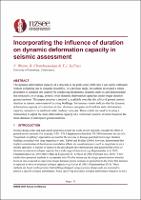| dc.contributor.author | Bhanu, Vishvendra | |
| dc.contributor.author | Chandramohan, Reagan | |
| dc.contributor.author | Sullivan, Timothy | |
| dc.date.accessioned | 2021-06-22T04:01:59Z | |
| dc.date.available | 2021-06-22T04:01:59Z | |
| dc.date.issued | 2021-04-14 | |
| dc.identifier.uri | https://repo.nzsee.org.nz/xmlui/handle/nzsee/2393 | |
| dc.description.abstract | The dynamic deformation capacity of a structure is the peak storey drift ratio it can safely withstand without collapsing due to dynamic instability. In a previous study, the authors developed a robust procedure to compute this quantity by conducting incremental dynamic analysis and demonstrated that structures, on average, possess lower dynamic deformation capacities under longer duration ground motions. This paper proposes a method to explicitly consider this effect of ground motion duration in seismic assessment of existing buildings. Preliminary results indicate that the dynamic deformation capacity of a structure at short durations compares well with its static deformation capacity computed via nonlinear static pushover analysis. These results are used to develop a relationship to adjust the static deformation capacity of a reinforced concrete structure based on the mean duration of anticipated ground motions. | |
| dc.language.iso | en | |
| dc.publisher | New Zealand Society for Earthquake Engineering | |
| dc.relation.ispartofseries | 2021;0071 | |
| dc.subject | Resilience beyond life-safety and amenity | |
| dc.subject | Advancements in structural and geotechnical design and assessment | |
| dc.title | Incorporating the influence of duration on dynamic deformation capacity in seismic assessment | |
| dc.type | Article | |

